A recent trip to northern Box Elder County produced some interesting raptors and uniquely challenging shooting conditions.
One thing I’ve learned about Barn Owls over the years is that they love to roost in haystacks (commonly composed of baled straw, not hay) so I always check them out for owls when I get the opportunity. There’s usually multiple nooks and crannies between the bales that they can hide out in and one can often find them perched out in the open in the early morning.
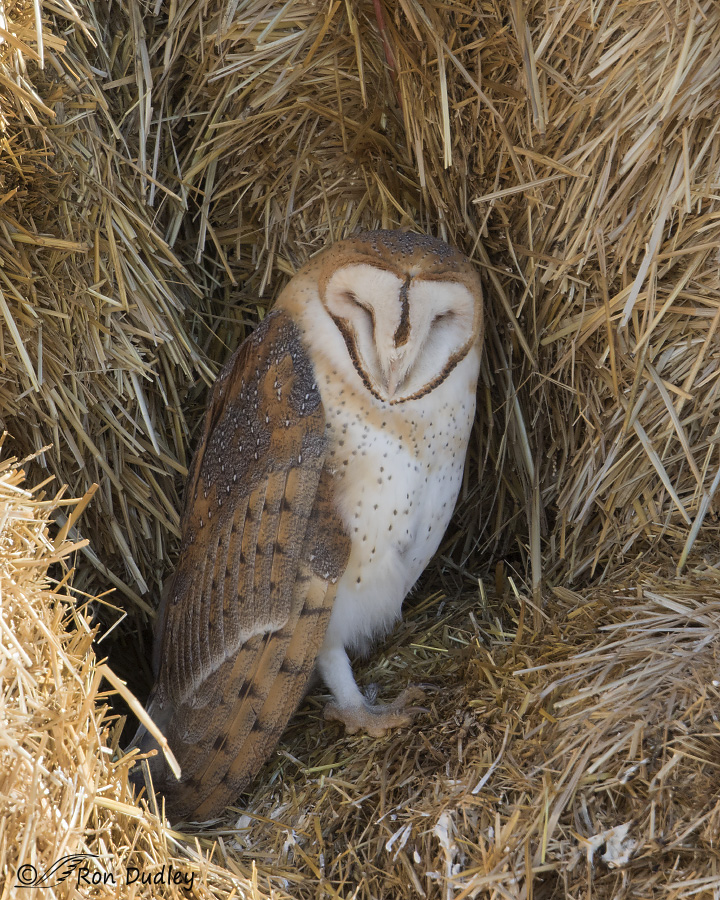 1/800, f/7.1, ISO 500, Canon 7D Mark II, Canon EF 500mm f/4L IS II USM + 1.4 tc, not baited, set up or called in
1/800, f/7.1, ISO 500, Canon 7D Mark II, Canon EF 500mm f/4L IS II USM + 1.4 tc, not baited, set up or called in
And sure enough, as I passed a stack of large straw bales in Blue Creek Valley on New Year’s morning this Barn Owl was perched among them. The problem was that it was tucked down in a shaded corner of the bales but surrounded by brightly lit hay which made it difficult for my active autofocus point to lock on to the bird so many of my shots were slightly soft.
Our winters are hard on Barn Owls and this sleepy bird was obviously conserving energy in a safe place on a very cold morning so I took a few shots from my pickup and then left it undisturbed.
Next I visited Blue Creek Springs where the water comes out of the ground at a constant, relatively warm temperature and often forms a small, elongated pond.
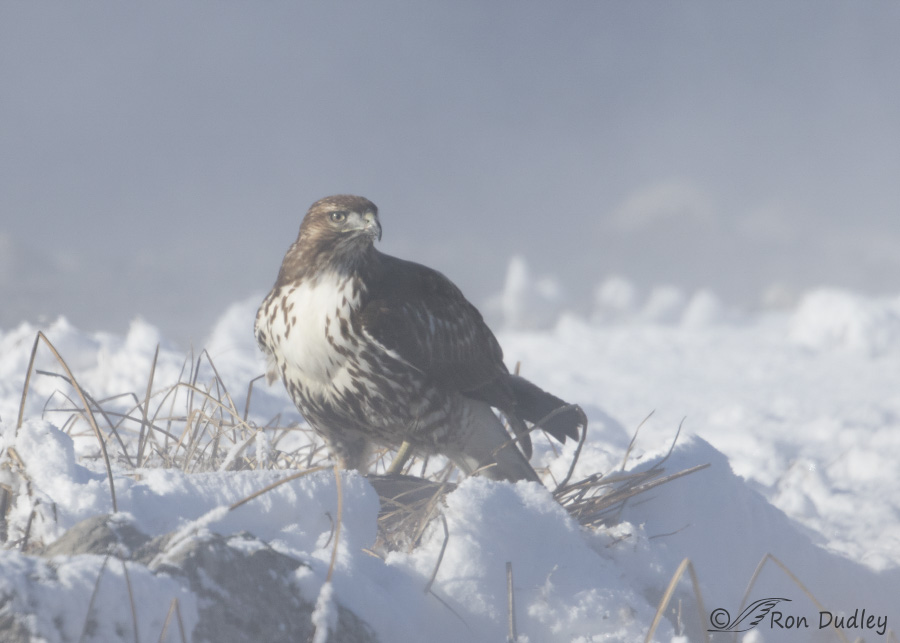
1/5000, f/6.3, ISO 500, Canon 7D Mark II, Canon EF 500mm f/4L IS II USM + 1.4 tc, not baited, set up or called in
As I drove down the road toward the spring outlet I encountered this juvenile Red-tailed Hawk perched in the snow next to the water. The contrast of temperatures between the very cold air and the warm water (directly behind the bird) produced misty vapor that washed over the hawk and made shooting conditions difficult. It was like photographing in fog except that the thickness of the mist was changing constantly and very, very quickly as the slight breeze pushed it in waves over the bird. This was actually one of the clearest shots I got of the hawk.
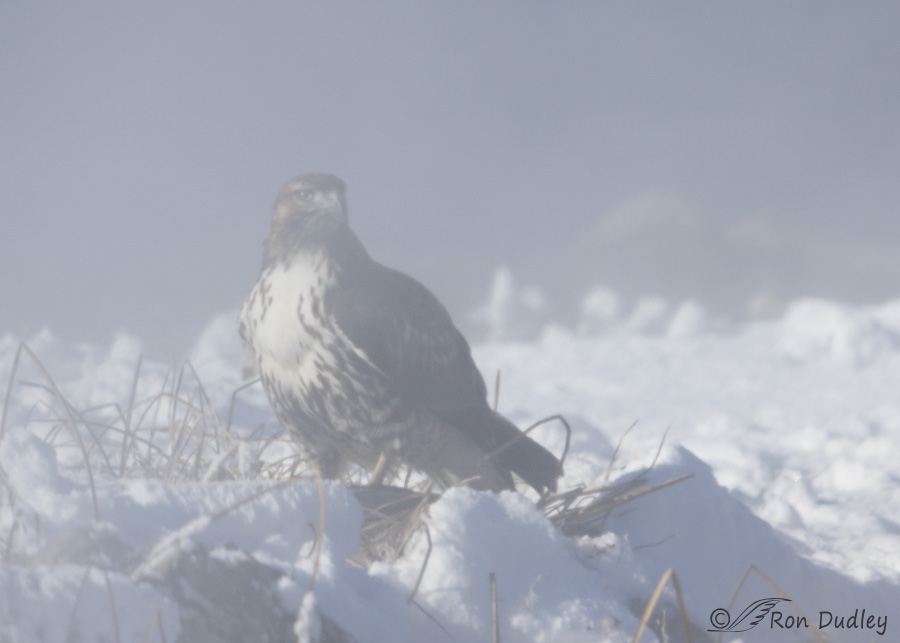
1/5000, f/6.3, ISO 500, Canon 7D Mark II, Canon EF 500mm f/4L IS II USM + 1.4 tc, not baited, set up or called in
Much of the time it was completely enshrouded in mist, to the point that I could barely make out its outline. This shot was taken only a second or two (maybe less) after the previous one.
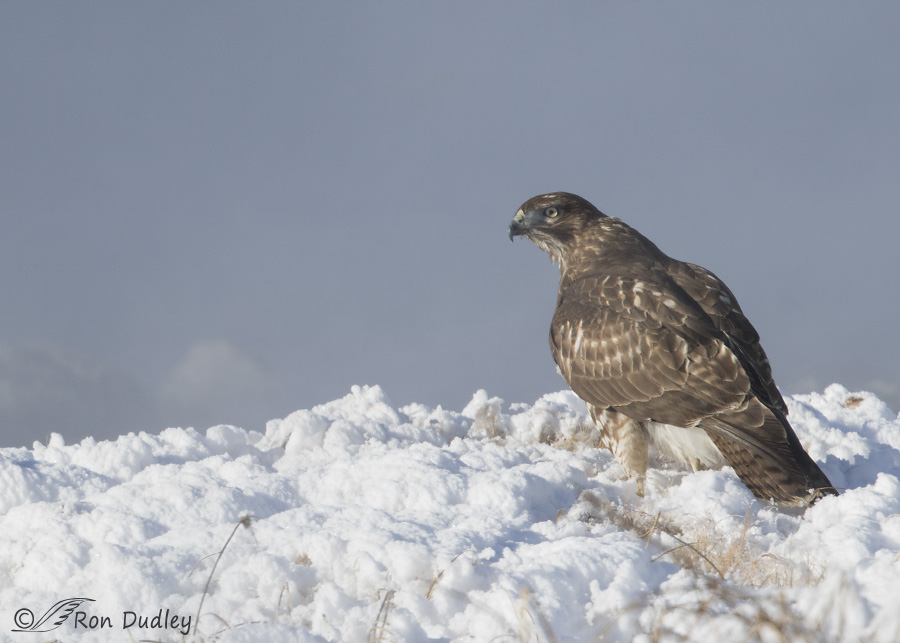
1/4000, f/6.3, ISO 500, Canon 7D Mark II, Canon EF 500mm f/4L IS II USM + 1.4 tc, not baited, set up or called in
After several minutes the hawk flew a few feet closer to the water (really more of a big hop than a flight) and I got this fairly clear shot of it in-between clouds of mist. You can see some of that mist coming off the water’s surface to the left in the frame.
At this point I thought the bird was about to fly off but it had something else in mind. I was unaware that there was now prey buried in the snow directly beneath and in front of its feet.
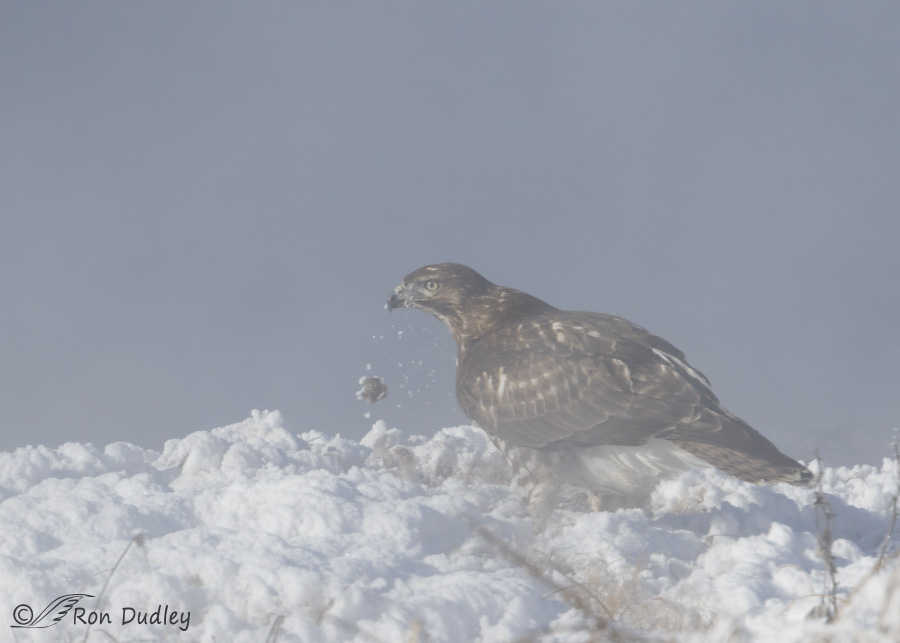
1/5000, f/6.3, ISO 500, Canon 7D Mark II, Canon EF 500mm f/4L IS II USM + 1.4 tc, not baited, set up or called in
The hawk fed on the prey for a short while but the mist was so thick that I couldn’t tell for sure what it was, though I believe what we’re seeing here is a clump of frozen feathers being dropped. The bird wasn’t particularly enthusiastic about feeding (I suspect it was an old carcass and in the first shots I can see that its crop was bulging slightly) and eventually…
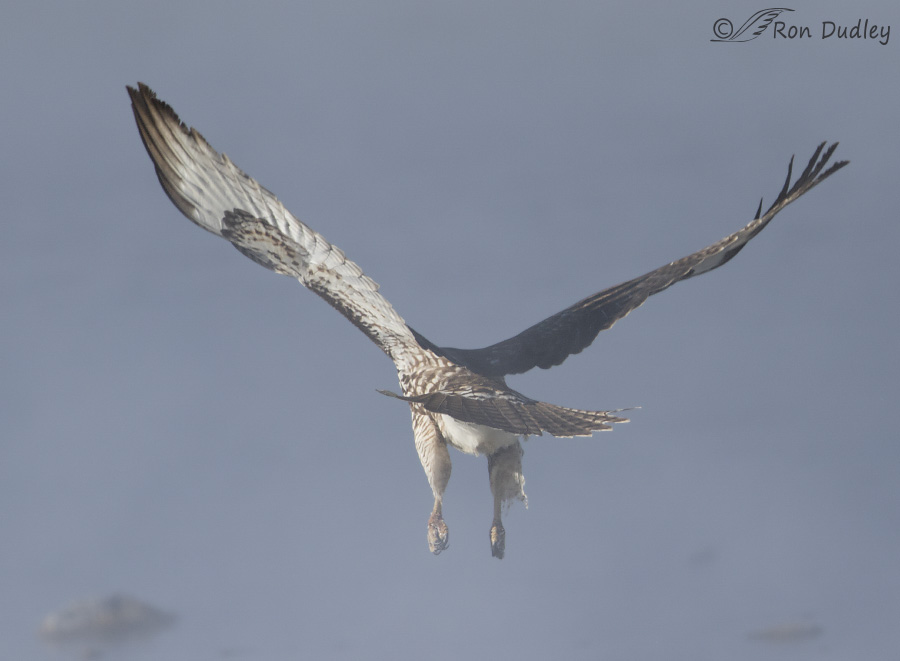
1/5000, f/6.3, ISO 500, Canon 7D Mark II, Canon EF 500mm f/4L IS II USM + 1.4 tc, not baited, set up or called in
it took off over the water and gave me some butt shots as it did so.
Largely because of the shooting conditions none of these images are great shots but these were interesting experiences with both birds so I decided to share.
Ron


Mark me down as not knowing there was a difference between hay and straw. 😀 Educational as always.
We’ll make a farmer/rancher out of you yet, Arwen!
Thanks for sharing this post. Difficult lighting seems to be a common problem when photographing birds. It seems most raptors I try to photograph have positioned themselves in poor light as part of their camouflage strategy. They are either in the shadows or have the sun at their backs which always causes me to either pass up the shot or end up deleting a lot of photos. It is also nice to learn that someone with your photographic expertise still has occasions when conditions just mess you up. I always look forward to learning something new when I read your blog.
“It seems most raptors I try to photograph have positioned themselves in poor light as part of their camouflage strategy”
Dennis, I’m absolutely convinced that Northern Harriers instinctively fly in-between any potential threat (photographers) and the sun because it makes them harder to see in that light. Also makes for poorly lit flight shots…
These are all nice shots, but especially love the one of the Barn owl snuggled into the straw bales. It looks so cozy, though it’s probably cold as hell. Brings back memories of fluffing up mounds of spun gold straw, and the satisfaction of putting down a clean bed once again for my best buddy, a horse named “Vienna”…topped off by a bucket of clean, sweet water, a cast iron corner bowl of oats and bran, and a couple of flakes of fragrant hay….then, all animals fed, I’d run like mad for the lights,warmth, and safety of the house. I’d burst ito the kitchen, out of breath, and my mother would ask, “What’s the matter?” I’d reply, “Nothing”, but in reality, I’d just run for my life with “It” at my heels….
Ha, I remember imagining some of the same monsters at my heels when I was a kid on the Montana farm, Patty – especially in the dark.
Love these images and the narrative. Thanks
Thanks on both counts, Sharon.
I enjoy all the shots – even soft focus so I can see what’s happening. Hawk are
fascinating.
Thank you, Linda.
I got so engrossed in these misty photos of the hawk that I burned my oatmeal! I know you prefer a sharper image, Ron. But I love these steamy images.
Cathryn
Sorry about the ruined oatmeal, Cathryn. I hope it was worth it! 🙂
Love these shots, Ron. It’s always special to see barn owls. I always marvel at the intricacy of their spectacular feathering. And just because I don’t know, what’s the difference between hay and straw? I’ve always thought those words meant the same thing? Although now that I think about it, why would we have two words if they didn’t mean different things? Hoping to learn something new today!
I love the shots of the redtail–you knew I would 😀 And it’s ALWAYS good to see juvies in January, particularly where the weather is consistently cold. They’re surviving and that’s good.
When I lived in Wyoming, we had a wonderful spring-fed creek that used to hold ducks all year round because it never froze. Mariah caught a bunch of ducks there. It was cool! Are there opportunities for ducks in that area or is it too small?
Straw is left over stems from cereal grains (wheat, barley)and generally used for bedding or roughage. Hay is grown for that purpose and green (for awhile anyway) such as Alfalfa and some grasses with, hopefully good nutritional value for feed. Judy
Cool! I’ve learned something new! That always makes a good day! THANKS! Of course, now the challenge is to keep it in there.
Laura, I occasionally see a few ducks there but not very many and not often.
Judy’s explanation of the differences between hay and straw is a good one.
Environment and behavior make the picture as much as sharpness sometimes. 🙂 Very enjoyable, Ron.
Thank you, Judy.